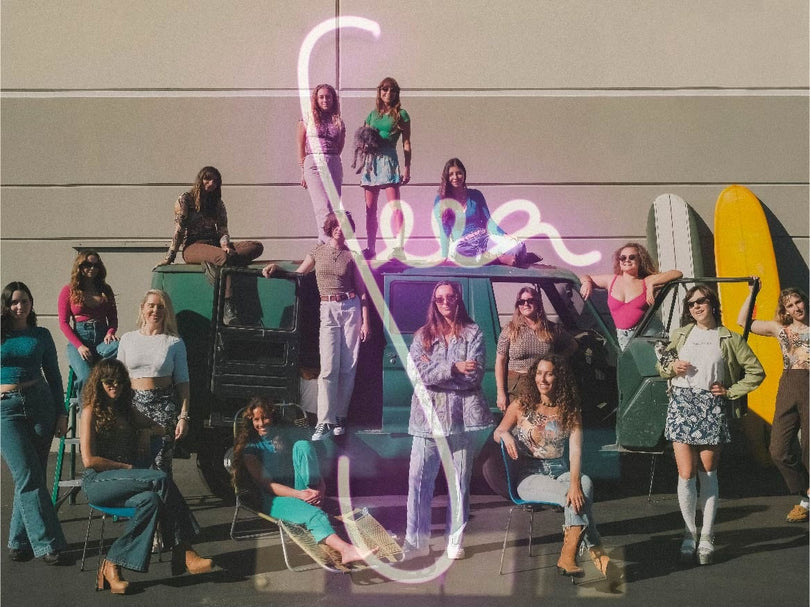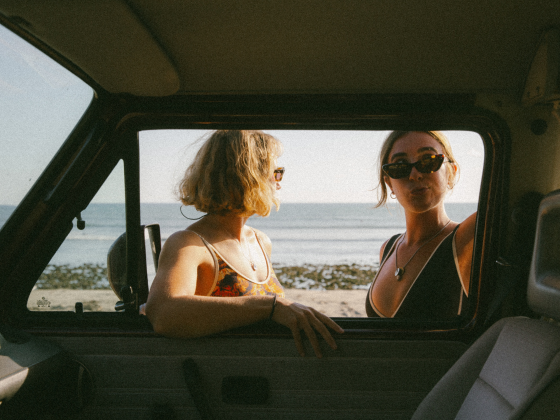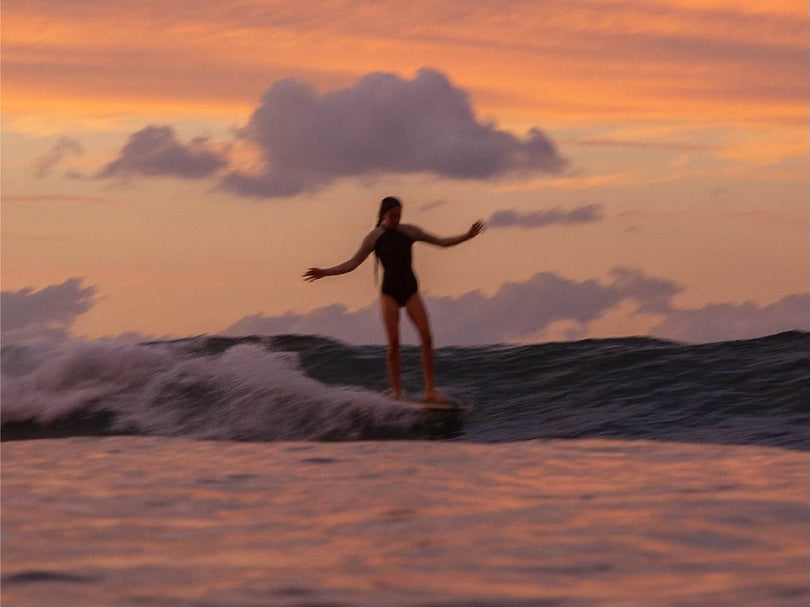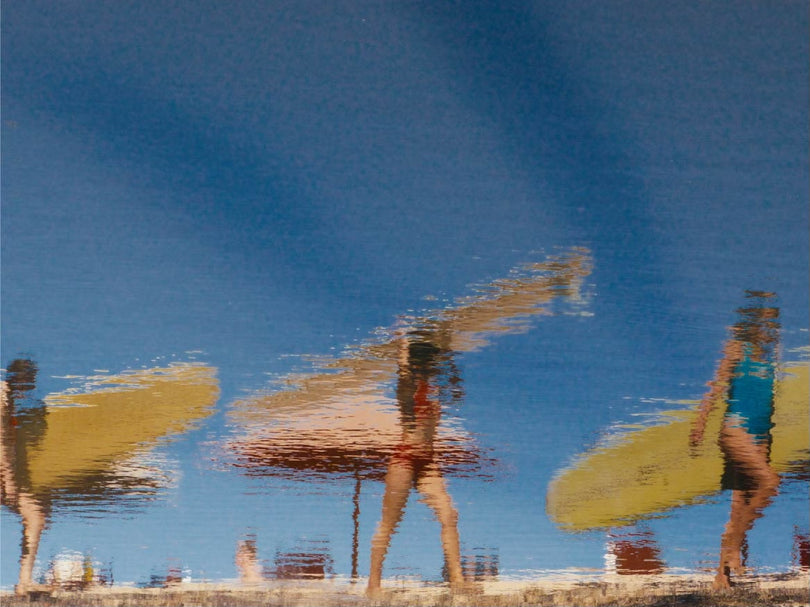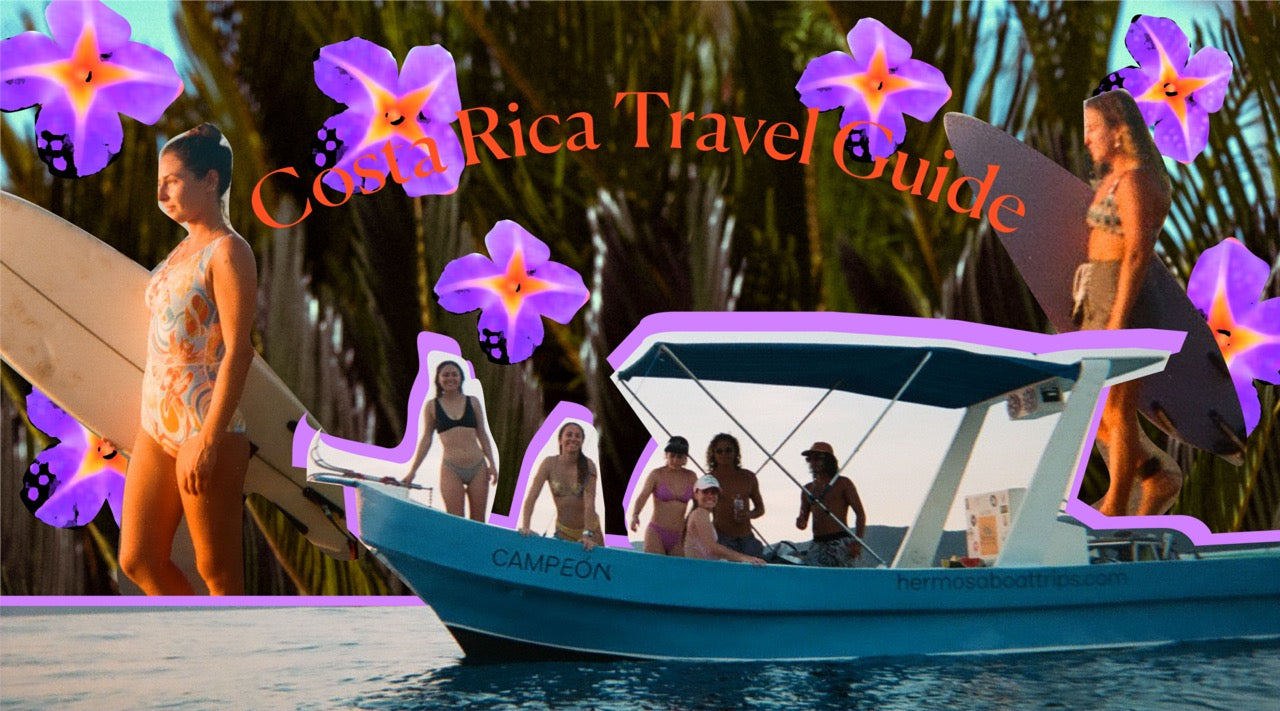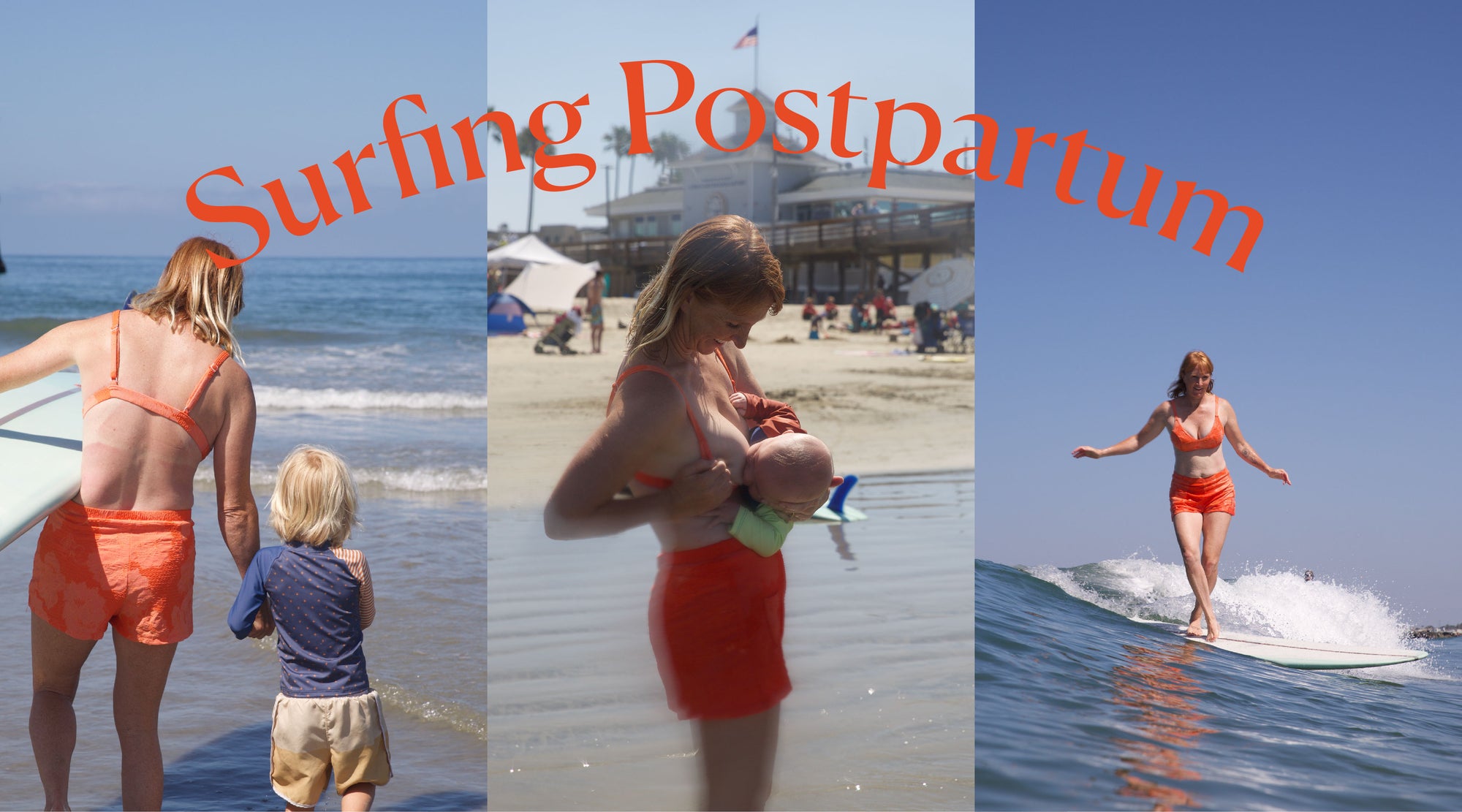Welcome to our second installation of 'In the Studio With...'!
In this series we share stories and highlight women - from artists to activists to scientists to stylists - who we find inspiring and all share the common thread of a love for surfing and the ocean.
In this second installment we're excited to feature Heather Hardison, a queer artist and surfer from the Bay Area.
Photos by Cassandra Cleave (unless otherwise notes)

Originally from North Carolina, they moved to the Bay after college to pursue art. Heather fell in love with the Bay, the rugged Northern California coastline and the creative community in and around San Francisco. Growing up in North Carolina, Heather spent a lot of time at the beach with their family, but they didn’t find surfing until moving to the Bay. After their first surf lesson, they were hooked, and from then on the surf bug welcomed itself into their system. Now, Heather combines their love of surfing, art, and community to create colorful murals, paintings, prints, and signs.
We sat down with Heather to learn more about their art, how they found surfing, and the community that they built through these two creative mediums. We are honored to introduce Heather Hardison as our second featured guest in our series ‘In the Studio with’.

Seea: Introduce yourself, where are you from and tell us a bit about your background!
Heather Hardison: I'm originally, originally from North Carolina. I grew up on the coast in eastern North Carolina, and studied art and design in school. I moved out to California after doing an internship, and fell in love with it and decided to move out here after college about 15 years ago. I started an apprenticeship at New Bohemia Signs and got into sign painting that way. I have been developing that practice and craft, as well as doing illustration and murals.
Seea: How did you first get into painting and printmaking?
Heather: I painted since I was young, and wanted to continue to do that. I wanted to go to art school, but I got a lot of encouragement to do something that felt like it had more of a practical job application after school. So I ended up studying design, but I painted as much as I could during that time through different classes. And then I found sign painting after I finished school, which felt like this blend of art and design, that was really nice.
I graduated school during the Great Recession, and there were not a lot of job opportunities, so I worked a cafe job and in an after school program. I was doing whatever work I could get. And then I found the sign painting apprenticeship which seemed like a path into a craft where I could make money doing something I wanted to do, which was a mix of art and design.

Seea: You worked for others for a little while, but how did you start to develop your own style and how did your personal artistic career start to unfold?
Heather: The whole time that I was apprenticing as a sign painter, I was continuing to work at night and do my own thing and make these illustrations. I was doing these illustrated food doodles for a food blog that I had. I was just putting things on there, and it would get reshared a lot, and so that's how I started making a little bit of a name for myself as more of an illustrator. Then for a long time I was working at the sign shop during the day, and then doing my moonlighting illustration jobs. It was a productive time, but I also got really burnt out, which is when I started surfing.

Seea: Surfing comes at the right time for so many people. Tell us how you started surfing!
Heather: Yeah, well with all the work I was doing, I was starting to get burnt out, and I realized I needed to make some changes. I wanted to reclaim play and joy and not just be all nose to the grindstone all the time like I had been. I grew up on the coast. I didn't surf when I was young, but I played in the water all the time, and my uncles were surfers. It was something that I always wanted to do, but I hadn't really had the access to it, even though I grew up by the coast. I didn't have women that I could surf with. My dad felt like it was really a dangerous thing for a girl to do, and I didn't have any models. At one point, one of my uncles gave me this little six foot tall thruster surfboard. And was like, “Here you go, kid.” I took that to the beach. I didn't have wax, I didn't know anything! We didn't have the internet yet so I couldn't look anything up. I took the board to the beach and got slammed on it a bunch in the shore break. I didn't even go to a surf spot. I was just getting pummeled on the shorebreak. And I was like, “Huh, surfing is really hard!”
Then after this period of burnout, I was just like, “I really want to try to learn to surf,” and I don't even know where that came from exactly, except that I missed the ocean. The ocean in Northern California is not the same as where I grew up at all. The water is so cold, it's so rocky, it's really uninviting. And I had been here for a long time already, really close to the ocean, but never going in and barely even really going to the beach. But for some reason I decided to sign my sister and I up for a surf lesson for her birthday, and I was hooked immediately! We were immediately able to get up! We were not going down the line or anything, but the satisfaction of popping up and standing on the giant foamy was great. The surf instructor was like, “You guys are pretty good at this. You should keep doing it.” I immediately was like, “This is what I want to do all the time.” And for a while I wasn’t doing much else!

{Heather Hardison surfing. Photo by: Nick Paz}
Seea: How did surfing and art start overlapping?
Heather: I was meeting a lot of people at the beach and talking to them about what I was doing, as a sign painter and stuff. Through organic conversations, I started getting connected with small shops. There was this place that burned down in 2020, called 2 Mile in Bolinas, California, rest in peace. I got in with the people there and did some design work and signs for them. From there it was just organic relationship building. I feel like almost immediately my surf life and design life started overlapping. There was this shop, it's still there, Traveler Surf Club in Pacifica. There's a couple of them now, but at the time, they were just opening up. They're a lesbian couple that runs it, and they're really connected, especially Julie Cox, who runs it. She's used to be pro. They knew other queer lesbian identifying surfers in the area. I was getting to know them, and painted some signs for Traveler. I was hanging out there, and I got to know a lot of people through that club.
Also, in the Bay Area art scene, there's the Mission School, which had a bunch of people that were surfers and artists. So it also felt like I was moving into an existing legacy of people that do sign painting, art, and are surfers. I didn't consciously choose to combine surfing and art, but it felt really organic that I was moving into an existing artistic, surfy culture. There’s this fluidity and dynamism to surfing and art in the Bay Area that takes a certain amount of grit. Doing both things in the Bay Area, being an artist and being a surfer takes a little extra determination or maybe willingness for punishment.
Seea: You’re a very community oriented person in both surfing and art. How does community play into your work?
Heather: Community is everything. In art, in surfing, in queer community, the community aspect, it's just the most important thing, and not only in and of itself, but the reciprocity and the growth that you can experience from community helps you. I've built so many wonderful relationships, in part through, not being a typical surfer, not being a cis white man that's been surfing since I was young. By seeking out other people who are women, other people who are queer, other people who are not the paradigm of traditional surfers, I feel like I have developed a really rich community. All of these people have helped uplift each other, share joy, and support when there is friction in the lineup.
Seea: You mentioned joy. Will you tell us a bit more what joy means to you?
Heather: When you're in flow and when you're connected, I feel like that is when there is joy. So in art, in friendship and surfing, that means doing those things for the right reasons. That's when you're doing something that's actually meaningful and making connections by doing it. There can be a lot of ego in surfing. It can be a lot about appearances. And I don't feel like that is a good thing about surfing in any way. I've actually recently gotten more into body surfing, and I love how pure and joyful it is. There's no ego in body surfing. No one's seeing what you're doing. You're just like, feeling the connection and the immersion. I love it.
I think if there's too much competition in it, for me, that starts eroding what feels good about surfing. And it can be the same with art too. So it's kind of an alignment with values and purpose. So back to community, having that as a core value and purpose in my art and in my surfing that helps me stay engaged in a meaningful way.

{Heather body surfing. Photo by Patrick Keenan}
Seea: How would you describe your art practice, and how is it evolving?
Heather: My art practice is always evolving. A life in the arts is a little bit like surfing in the sense that things are always changing, and the conditions are changing rapidly, and you're having to adapt.
One thing I've been trying is to do more public art with murals that are in public spaces for the community. I have done a lot of murals, but they were commercial. My practice is always just trying to stay in line with values. I am also trying to do personal art because for a long time I was just doing a lot of client projects.
Seea: What are your future aspirations in both surfing and art?
Heather: I'm always looking to bring my surfing and my art practice closer together. I would love a day when my art and my studio are physically closer to the water, so that they're a little more integrated in a single day. Also, to continue to align surfing and my art with my values because it is easy to get too goal oriented in a way that is constricting. And the same thing with my art. It is about showing up with the intention of doing my best and not getting too caught up with outcomes and putting pressure on a thing that ultimately needs spaciousness and fluidity. When that constriction happens, that tension disrupts the flow and creativity of both of those things. So it's always a management of interior and exterior pressures to maintain spaciousness.
Seea: What do you hope for the future of surfing?
Heather: I went to Switch, a queer surf event this last weekend. Shout out to Queer Surf! I just want the lineup to feel more inclusive whether it's more queer, trans, non-binary people, people of color, older people. I want the lineup to feel like a safe space for everyone because that joy and aliveness is important for everyone. There is so much joy and knowledge in the ocean that needs to be available to everyone. I want to see people being called into waves, party waves, less scarcity mindset, more inclusivity, more joy!

Heather's Pick:
Find some of Heather's Seea picks for in the studio and in the water.

